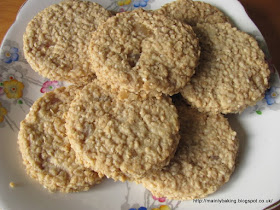As a sort of antidote to Christmas, when chocoholic cooks often try their best to impress their friends and family with showstopping desserts, cakes and other home-made treats, the theme for
this month's We Should Cocoa challenge is........
Simple Recipes!
The We Should Cocoa challenge, to use some form of chocolate together with a monthly theme, was devised by Choclette at
Tin and Thyme, but this month's theme of
Simple Recipes has been chosen by guest-host Lisa, at
Lovely Appetite.
I guess everyone's idea of simple will be slightly different, but to me, a simple recipe is more about ease and speed of preparation and cooking rather than the number of ingredients. After all, there aren't many ingredients in a macaron, but only an expert would call then 'simple' to make!
The recipe for Chocolate and Ginger Flapjack couldn't be much more simple - melt chocolate, butter, golden syrup and sugar together in a large bowl in the microwave (or in a pan on the hob, if you prefer). When all the chocolate has melted and the mixture is quite hot, stir in rolled oats and crystallised ginger pieces. Transfer to a baking tin, bake, cool and eat - simple!

To make sure the flavour of the flapjack wasn't as simple as it's recipe, I used 100% cacao, and the ginger was from a Christmas box of Turkish crystallised ginger pieces which were really fiery - I don't think I've ever eaten ginger that hot before! The bitterness of the cacao, and the heat of the ginger, gave these flapjacks a taste which might not appeal to children, but the effect could be toned down by using a chocolate with a lower percentage of cocoa solids (say 60-70%) and a milder ginger, or even replacing some of the ginger with dried fruit such as chopped dried apricots, so that the flapjacks taste sweeter.
Ingredients
100g dark chocolate or 100% cacao (I used Willie's Peruvian Black 100% Cacao)
100g butter
65g golden syrup
100g caster sugar
250g rolled oats
100g crystallised ginger, chopped into pieces about 1cm cubed
(leaving the chunks of ginger quite large makes sure you get a good hit of the heat when it's eaten!)
Method
Pre-heat the oven to 180C (160C fan) and line the base and sides of a 20cm (8") square baking tin with baking parchment.
Melt the chocolate, butter, syrup and sugar in a saucepan on the hob, or in a bowl in the microwave. The mixture needs to be quite hot to dissolve the sugar, but doesn't need to boil.
Add the oats and the pieces of ginger to the chocolate mixture and stir until the oats are well coated.
Transfer the mixture to the baking tin and spread into an even layer, pressing down firmly with the back of a spoon.
Bake for 25 minutes, then cool for 10 minutes. at that point, while still warm, mark into squares or fingers of the desired size. Leave in the tin until completely cold.
This recipe makes flapjacks which stay together well and are chewy rather than crisp and crunchy. If you prefer crisp flapjacks bake for a little longer - another 10 minutes, perhaps.
I'm also entering these flapjacks into
January's AlphaBakes challenge, where co-host Ros, at
The More Than Occasional Baker has chosen the letter G. Ros alternates her hosting duties with Caroline, at
Caroline Makes.
G is for Ginger, in this instance, of course!
 I've used this recipe before, when I've had a substantial amount of leftover shortcrust pastry. Last time I reduced the sugar in the original recipe and made savoury oat biscuits, this time I left in the suggested amount of sugar, added some sesame seeds and some crystallised ginger and made some fairly plain, not too sweet, biscuits which provided welcome relief from the excesses of rich food over the Christmas period.
I've used this recipe before, when I've had a substantial amount of leftover shortcrust pastry. Last time I reduced the sugar in the original recipe and made savoury oat biscuits, this time I left in the suggested amount of sugar, added some sesame seeds and some crystallised ginger and made some fairly plain, not too sweet, biscuits which provided welcome relief from the excesses of rich food over the Christmas period. It's more of a baking tip than a recipe - you weigh your pastry leftovers, then add the same weight of rolled oats and half that weight of butter and sugar. I started with 180g of shortcrust pastry, so added 180g of oats, 90g butter and 90g of soft brown sugar. I also added 2 tablespoons of sesame seeds and 50g of finely chopped crystallised ginger.
It's more of a baking tip than a recipe - you weigh your pastry leftovers, then add the same weight of rolled oats and half that weight of butter and sugar. I started with 180g of shortcrust pastry, so added 180g of oats, 90g butter and 90g of soft brown sugar. I also added 2 tablespoons of sesame seeds and 50g of finely chopped crystallised ginger.











